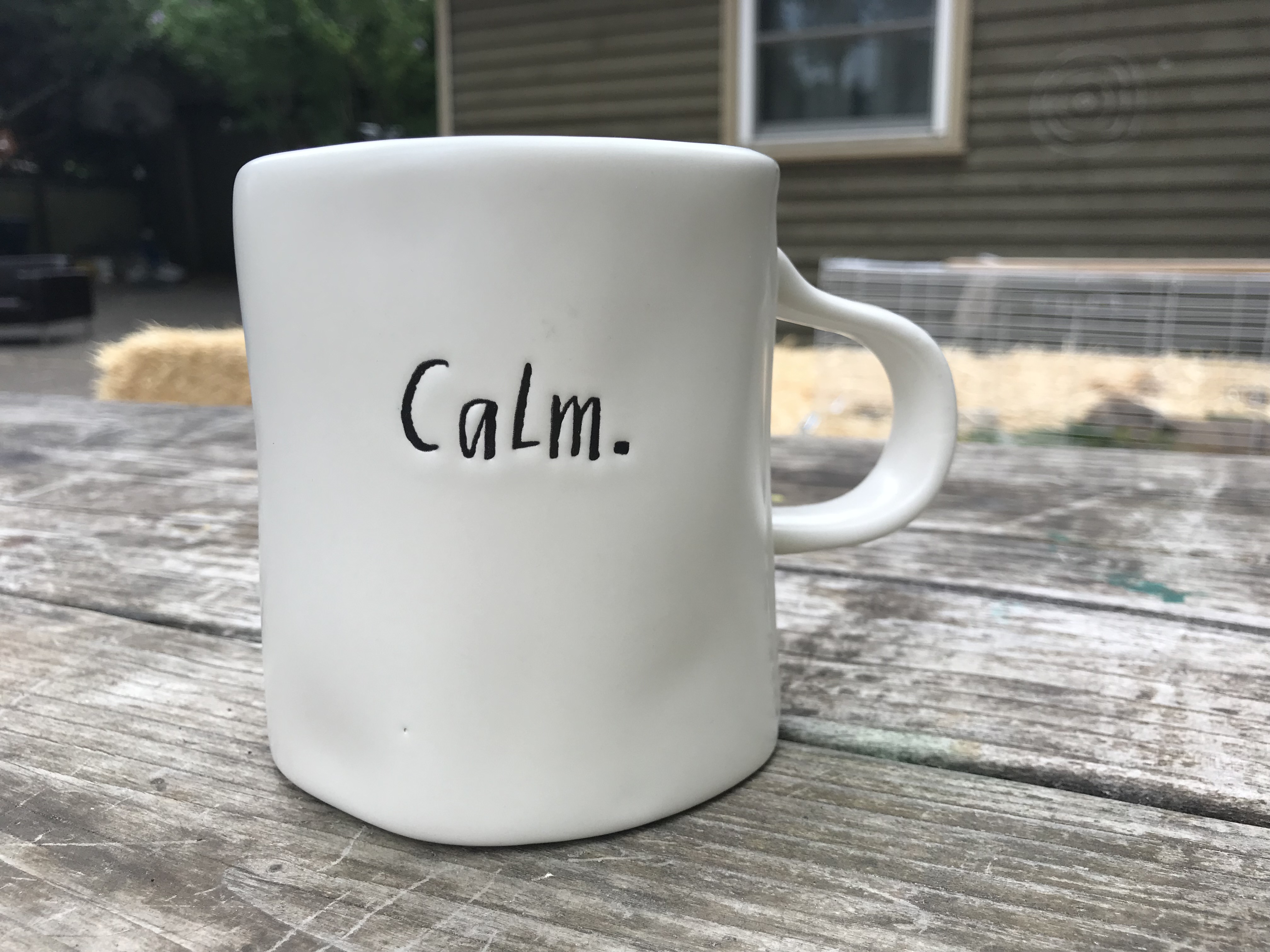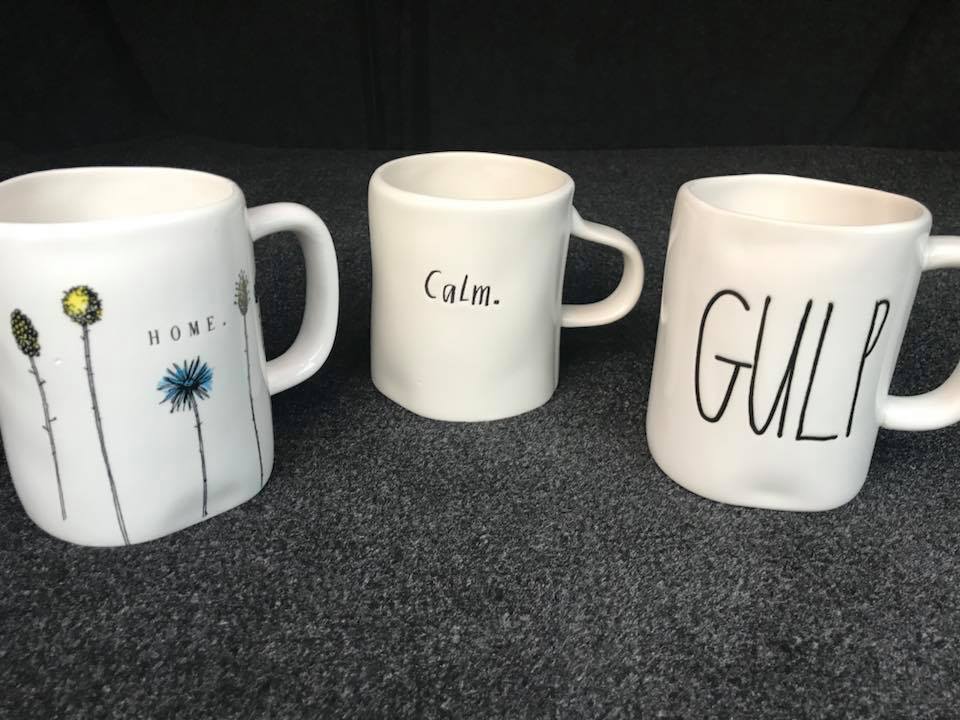Rae Dunn ceramic “Calm” coffee mug purchased at Marshall’s: 100 +/- 20 ppm Lead (within safe range for Lead)
For those new to the Lead Safe Mama website:
Tamara Rubin is a multiple-federal-award-winning independent advocate for childhood Lead poisoning prevention and consumer goods safety, and a documentary filmmaker. She is also a mother of Lead-poisoned children (two of her four sons were acutely Lead-poisoned in 2005).
- Tamara owns and runs Lead Safe Mama, LLC — a unique community collaborative woman-owned small business for childhood Lead poisoning prevention and consumer goods safety.
- Since July of 2022, the work of Lead Safe Mama, LLC has been responsible for five product recalls (FDA and CPSC).
- All test results reported on this website are science-based, accurate, and replicable.
- Please check out our press page to see some of the amazing coverage of our work so far this year!
Ceramic Rae Dunn brand “Calm.” coffee mug (Made in China) purchased at a Marshall’s in Portland, Oregon for about $5 in August 2018
Tamara, why are you testing Rae Dun pieces?
I’ve chosen to test products from Rae Dunn periodically (when I have access to new examples) because, while many of their products are in the “lead-safe” range (a label I personally reserve for items that test at or below approximately 100 parts per million [ppm] Lead when tested with an XRF instrument), since I first learned of Rae Dunn ceramics I have found a few items from this brand with Lead levels I would not consider within an acceptable range. I have therefore been curious to learn if this was more one type of product over another from this line (dark glaze vs. light, for example, or matte glaze vs. gloss) or if it was a random set of findings for just a few specific pieces.
Rae Dunn “Calm” Mug
Description: Matte finish inside and out. Appears to be clear finish over white clay base. Black glazed decorative writing depressed into the ceramic. Continue reading below the image.
XRF test results for the mug pictured here:
Back (matte finish) outside white side (no black writing within scope, a.k.a the testing window)
- Lead (Pb): 100 +/- 20 ppm
- Cadmium (Cd): non-detect (negative within the testing limits of the XRF)
- Mercury (Hg): non-detect (negative within the testing limits of the XRF)
- Arsenic (As): non-detect (negative within the testing limits of the XRF)
- Barium (Ba): 360 +/- 61 ppm
- Zinc (Zn): 17,700 +/- 600 ppm
- Iron (Fe): 1,290 +/- 196 ppm
- Bismuth (Bi): 117 +/- 24 ppm
- Vanadium (V): 607 +/- 75 ppm
- Titanium (Ti): 1,201 +/- 123 ppm
- Zirconium (Zr): 2,704 +/- 89 ppm
Section with black writing in scope:
- Lead (Pb): 63 +/- 16 ppm
- Chromium (Cr): 10,500 +/- 800 ppm
- Zinc (Zn): 9,088 +/- 314 ppm
- Copper (Cu): 101 +/- 41 ppm
- Iron (Fe): 12,600 +/- 600 ppm
- Bismuth (Bi): 120 +/- 20 ppm
- Cobalt (Co): 3,008 +/- 240 ppm
- Manganese (Mn): 6,544 +/- 522 ppm
Some additional reading for those new to my page:
- To see more examples of Rae Dunn pieces Lead Safe Mama has tested, click here.
- To learn more about XRF testing, click here.
- Read More: Can I test my dishes with a LeadCheck swab?
- To learn more about the concern for ANY Lead in functional pottery pieces, click here.
In summary (for this mug and other Rae Dunn pieces):
- This particular mug would fall in the “Lead -safe” range (about or below 90 ppm Lead when taking into account the margin of error for the reading).
- The Rae Dunn white surfaces seem to consistently test in the “low-Lead”/ or “Lead-safe” range for glazes.
- The brightly colored Rae Dunn decals are higher in Lead content generally (in the 600 to 1000 ppm range) compared to the white backgrounds.
- The matte vs. shiny white finish makes a slight difference in the Lead readings as well, but not significant.
As always, please let me know if you have any questions!
Thank you for reading.
Tamara Rubin
#LeadSafeMama
Never Miss an Important Article Again!
Join our Email List











Hi Tamara,
Great website and appreciate the information. Are the Colored Rae Dunn Mugs are considered “safe” lead levels ( green, blue, orange red, etc) and the black interior on some cups the worst offenders for lead?
Thanks!
Cindy
I have three rae dunn ceramic canisters (china) on my counter that have soil in which I grow herbs in. Do you consider this to be a safe use?
The interior of those canisters is likely lead-safe (below 90 ppm Lead). Are they white? Is the interior white?